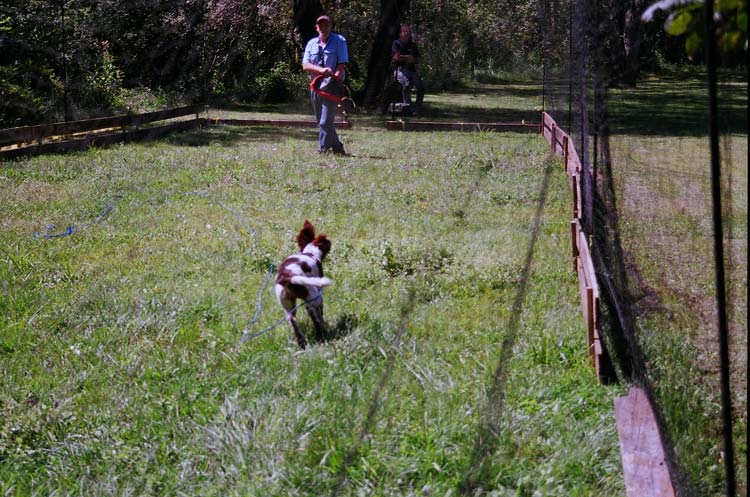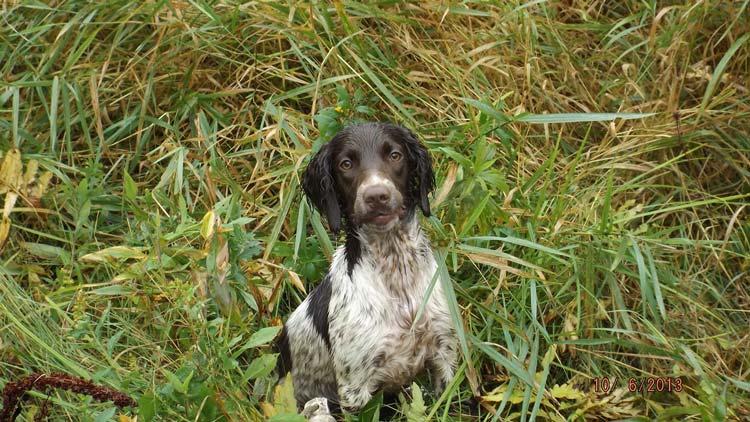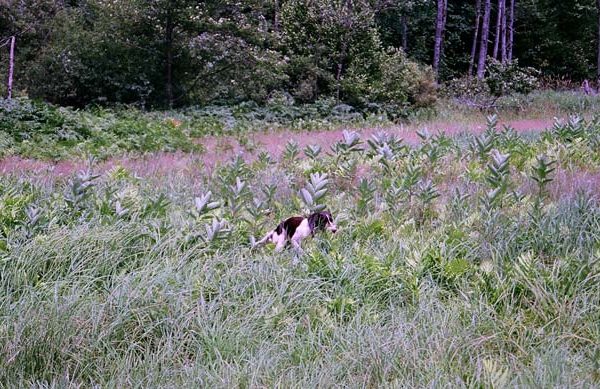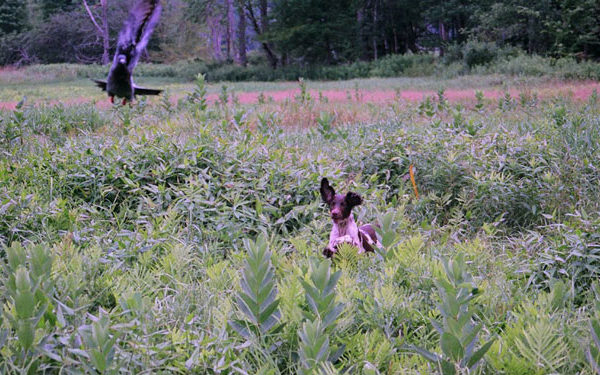
Last month we reviewed the “baseball” concept or as many know it,” three hand casting.” This month I will go through the technical procedure that I use for “lining” a spaniel. As I mentioned last month, the lining drills may be taught at the same time you are teaching three- hand casting. However these drills must be introduced separately and conducted in a different location. Keep in mind that we are constructing a puzzle. For now, we are only crafting the pieces and are not quite ready to put any of the pieces together. Once the pieces are established, we will be able to join them and form a meaningful picture for the spaniel to understand easily.
Proper lining is the initial stage in directing your spaniel to travel in the general direction of the downed bird. This procedure is used in “blind retrieve” scenarios, meaning the dog is asked to leave your side and retrieve a bird that he did not see fall. Sometimes you will line the dog directly to the fallen area. However in some instances you may decide to line you spaniel slightly off line of the fallen bird. To allow your spaniel’s nose to take advantage of the wind. Making it easier for your spaniel to seek and retrieve the shot game. Oh yes, wind direction is very important! There are three key points to remember. First, Spaniels sent in a crosswind will tend to fade with the wind as they continue to travel their initial line. Naturally the longer the line the more pronounced the drifting would be. Second, going into the wind often leads to short retrieves due to the presence of downwind scent. If a spaniel will ever come up short on a blind, it will probably happen when making a blind retrieve into the wind. Finally put the wind at you back and it will help to drive the spaniel deep on its initial line! Keep these wind factors in mind as you advance through the lining drills. Use the wind to your advantage and keep things simple for the spaniel in the beginning stages of training.
First, you must locate a field that is fairly flat with few hazards or distractions. I view the optimal size at-least two hundred yards wide and the same distance in length. Ideally you will be able to keep things set up and return to this area daily while you are teaching this drill. The cover should be very minimal in the beginning stages of training. We want our spaniel to succeed and gain in confidence as they learn these new tasks. Gradually increase the cover height as they build confidence. At my kennel, we typically will mow a field and let it grow while we are teaching pattern blinds. The increase in cover is gradual, and the spaniel slowly learns to trust you direction.
Next, find the center of the field and mark it. I use a broom handle that has one end sharpened to a point. Push the pointed end into the ground. This will make the starting point that all your lining drills will begin from for now. With the help of some surveyors, flags, place four flags approximately 50 to 60 yards away from the starting broom handle, and space them 90 degrees apart from each other. Initially, we do not want to make the lines too far away. We are creating a circle and dividing it into four equal parts or lines to teach the spaniel basics of pattern blinds. This will help in teaching the spaniel to carry a straight line in all different wind directions.
This beginning stage of teaching a spaniel to line is crucial! This is where we will set the dogs attitude on taking the initial line for running a blind retrieve. Either the dog will have enthusiasm, confidence and desire upon taking the line for a blind. Or you could cause resent-fullness and an unenthusiastic attitude towards lining for the blind retrieve. Be patient and teach the spaniel to have confidence in its line and the attitude there is a bird out there to be found. This must initially be a technical drill that is fun for your spaniel. Keep things simple. There is very little punishment used during the beginning stages of training.
With the field laid out and established. Now we can begin to set up our spaniel for their initial line. A dog must be properly lined before we send them. How do we know when our spaniel is properly lined? We should be able to draw an imaginary straight line from the base of the dogs’ tail, through his spine, to the top of their head and down the field to the fallen bird. Only when the dog is properly lined and is looking in the direction of the fall, should you send your spaniel!! If the spaniel is distracted, or not properly aligned. Heel them off the line and begin again to set the proper lining technique. We want to ensure success, so that the dog understands whenever they are sent on a blind they will find a bird.
Now we are going to use several commands: “Dead bird” in the beginning stage will be our “Q” for identifying the dummy pile.” LINE” will be used to “Q” the spaniel that they are looking in the proper direction and is properly aligned. “BACK” means for the dog to go, leaving your side and traveling that line until the blind bird is found.
Well we are ready to start, grab four white dummies and your new student. Starting at the center point of the four lines, face the flag that will put the wind at your back first. With your spaniel on lead, walk down the line to the surveyors flag. Have your spaniel HUP about four yards away, facing the flag. Take the four dummies and toss them down in front of the flag. Give a verbal command of “DEAD BIRD” every time you toss a dummy down. This will help in “Qing” your spaniel later, when you are performing a cold blind retrieve. Try to separate the dummies as you throw them down. This will discourage “switching” at the pile. We are not however, worried about switching issues here! Do your best to encourage the dog to pick one dummy up and return as quickly as possible.
OK take your spaniel and heel them away from the pile ten yards or so. Turn and HUP them facing the pile. The dog should be able to see the dummies easily. The spaniel should be perfectly lined in the direction of the pile. Place your left hand out in front of him above his head. Now give the commands DEAD BIRD, LINE and BACK to send them. Some may be reluctant to leave. You may have to take a step forward to encourage them to leave repeating the command BACK. While they are in route to the pile for a retrieve. Turn and walk back toward the starting point pole to extend the line to the pile slightly longer. The goal is to have the spaniel running the entire length of the line from the starting point to the pile in your first session. Help your student if they get confused and or fails to take a straight line. You can do this by calling them back and moving up about three quarters of the way to the pile. HUP them, walk out to the pile, toss a dummy and give your DEAD BIRD command. Return to their side and send them on Back for the retrieve.
Once this is taught, you can now begin to establish the other lines that were prepared earlier. Teach one line at a time. Eventually, you will have established all four lines with your spaniel. Each time, begin by walking out to the pile and identifying the dummy pile. Walk back to the starting point and send your spaniel with the command sequence we discussed above and an enthusiastic BACK at the end! We now have shown the dog how to take a straight line in all four different wind directions! You do not have to require the spaniel to pick up all the dummies at each pile. I prefer to send them to one pile and get a single retrieve. Then move them to another line for another retrieve at that pile. Keep mixing it up, when an issue or confusion arise at a specific line. Always send the dog back down that line for another retrieve at least once.
The next step is to slowly teach the spaniel to run an established line” COLD”. Start with one pile at a time and progress as the dog begins to understand. Here is the scenario, put a pile out on one line before bringing out the dog. Run the first line to that pile by “identifying” the pile. Then pick up run the spaniel to the rest of the pile with the start of a “COLD” line. Walk half way up to the pile HUP them down command “DEAD BIRD”. When properly lined and looking in the proper direction extend your hand out in front and give the “GOOD” command. Then give a rousing “BACK” command to send for the retrieve. Try to keep this simple at first by moving as close as necessary to the pile for the first few lines that are ran COLD. Naturally extend the line as quick as possible.
As you progress through this phase of training. The necessity of proper lining becomes evident. Sometimes the dog will not be properly lined or may look in the wrong direction. This is the time we teach them the “NO” command. When they are improperly lined give them a “NO”. Heel the dog and walk a few yards down the line towards the pile to correct them. By completely moving the dog when improperly lined, I believe that we help the spaniel to understand the meaning of “NO” in this context. It is my experience that you must move the dog to facilitate the lesson. Simply pushing the dog’s head in another direction seems to confuse the spaniel. It will take longer for the dog to understand the difference between “LINE” and “NO” commands and can lead to frustration. Once properly lined, go through the three commands, now we are teaching proper ethics on lining.
After repeating these cold blinds many times, your dog should be able to run the four lines cold in one session. Now, we can start to extend the line to 100 yards. All you need to do is move the flags out (slowly) to the 100 yard mark. Ten to fifteen yard increments is acceptable. This stage must be completely taught before going to the next level. Eventually, we will add some additional lines. Putting a pile at 60 yard in between every 100 yard pile. You now should have a drill that is starting to look like a wagon wheel. Introduce these new lines one at a time. Always identifying the pile as needed. The goal is to eventually run all eight lines to the piles COLD. Here is where the spaniel will be tempted to run an improper line. Should they leave and head for an improper pile. Wait until they are halfway to the pile and command “NO HERE” bringing the spaniel back to correct their line. You may have to move up. Finally they should be running all eight lines COLD. Four lines 60 yards and four lines at 100 yards.
Next step we are going to choose the line we want them to run. Start out by sending on the first chosen line. Then choose the next line and HUP them. Give a DEAD BIRD, NO and HEEL command. Move them to another random chosen line. Set them up and send them to that pile. We are now teaching them that “NO” means not this line and “LINE” means that this is the line I would like you to run.
The final stage should be all eight lines ran cold. You could even start to introduce a dummy along the way to a pile. This will teach them that there could be a bird along the way. Next month I will address the remote “HUP” and we will start to put some of the puzzle together.





